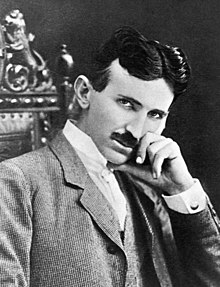Nicolas Tesla

Nicolas Tesla
Nikola Tesla
| |
|---|---|

Nikola Tesla, c. 1896
| |
| Born | 10 July 1856
Smiljan, Austrian Empire(modern-day Croatia)
|
| Died | 7 January 1943 (aged 86)
New York City, United States
|
| Resting place | Nikola Tesla Museum, Belgrade, Serbia |
| Citizenship | Austrian (1856–1891) American (1891–1943) |
| Education | Graz University of Technology(abandoned) |
| Engineering career | |
| Discipline | Electrical engineering, Mechanical engineering |
| Projects |
|
| Signature | |
Nikola Tesla (/ˈtɛslə/; Serbo-Croatian: [nǐkola têsla]; Serbian Cyrillic: Никола Тесла; 10 July 1856 – 7 January 1943) was a Serbian-American inventor, electrical engineer, mechanical engineer, and futurist who is best known for his contributions to the design of the modern alternating current (AC) electricity supply system.
Born and raised in the Austrian Empire, Tesla received an advanced education in engineering and physics in the 1870s and gained practical experience in the early 1880s working in telephony and at Continental Edison in the new electric power industry. He emigrated to the United States in 1884, where he would become a naturalized citizen. He worked for a short time at the Edison Machine Works in New York City before he struck out on his own. With the help of partners to finance and market his ideas, Tesla set up laboratories and companies in New York to develop a range of electrical and mechanical devices. His alternating current (AC) induction motor and related polyphase AC patents, licensed by Westinghouse Electric in 1888, earned him a considerable amount of money and became the cornerstone of the polyphase system which that company would eventually market.
Attempting to develop inventions he could patent and market, Tesla conducted a range of experiments with mechanical oscillators/generators, electrical discharge tubes, and early X-ray imaging. He also built a wireless-controlled boat, one of the first ever exhibited. Tesla became well known as an inventor and would demonstrate his achievements to celebrities and wealthy patrons at his lab, and was noted for his showmanship at public lectures. Throughout the 1890s, Tesla pursued his ideas for wireless lighting and worldwide wireless electric power distribution in his high-voltage, high-frequency power experiments in New York and Colorado Springs. In 1893, he made pronouncements on the possibility of wireless communication with his devices. Tesla tried to put these ideas to practical use in his unfinished Wardenclyffe Tower project, an intercontinental wireless communication and power transmitter, but ran out of funding before he could complete it.
After Wardenclyffe, Tesla experimented with a series of inventions in the 1910s and 1920s with varying degrees of success. Having spent most of his money, Tesla lived in a series of New York hotels, leaving behind unpaid bills. He died in New York City in January 1943. Tesla's work fell into relative obscurity following his death, until 1960, when the General Conference on Weights and Measures named the SI unit of magnetic flux density the tesla in his honor. There has been a resurgence in popular interest in Tesla since the 1990s.
He is a scientist, a man and a inventor from Serbia. He has many outstanding contributions in the field of electromagnetic energy.
Nicolas invented the electric motor after inventing his patents and theories on all the bases of alternating or alternating electric power.
In promoting the Second Industrial Revolution.
He has also worked on the invention of radio, and has made many important contributions in the fields of radio communication, as well as in the development of radar, robotics, computer science and remote control, in addition to nuclear physics, theory and ballistic expansion.
He was nicknamed by many titles, including the saint, the modern electrician, the father of physics, and the man who invented the twentieth century.











0 Comments